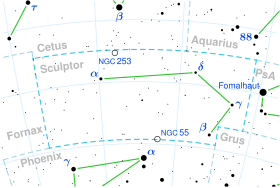Star in the constellation Sculptor
π Sculptoris , Latinized as Pi Sculptoris , is candidate astrometric binary star system in the southern constellation Sculptor , positioned near the eastern constellation border with Fornax . It has an orange hue and is dimly visible to the naked eye with an apparent visual magnitude of 5.25. Based upon parallax measurements, the system is located at a distance of 66 light years from the Sun, and is drifting further away with a radial velocity of +14 km/s.
The visible component is an aging giant /bright giant star with a stellar classification of K1II/III. It is a red clump giant, which indicates it is on the horizontal branch and is generating energy through core helium fusion . The star has 1.5 times the mass of the Sun and 9.3 times the Sun's radius . It is radiating 41 times the luminosity of the Sun from its swollen photosphere at an effective temperature of 4,800 K.
References
^ Brown, A. G. A. ; et al. (Gaia collaboration) (August 2018). "Gaia Data Release 2: Summary of the contents and survey properties" . Astronomy & Astrophysics 616 . A1. arXiv :1804.09365 . Bibcode :2018A&A...616A...1G . doi :10.1051/0004-6361/201833051 .Gaia DR2 record for this source at VizieR .
^ Anderson, E.; Francis, Ch. (2012). "XHIP: An extended hipparcos compilation". Astronomy Letters . 38 (5): 331. arXiv :1108.4971 . Bibcode :2012AstL...38..331A . doi :10.1134/S1063773712050015 . S2CID 119257644 . Vizier catalog entry
^ Liu, Y. J.; et al. (2007). "The abundances of nearby red clump giants" . Monthly Notices of the Royal Astronomical Society . 382 (2): 553. Bibcode :2007MNRAS.382..553L . doi :10.1111/j.1365-2966.2007.11852.x .
^ Houk, N. (1982). Michigan Catalogue of Two-dimensional Spectral Types for the HD stars. Declinations -40_ƒ0 to -26_ƒ0 . Vol. 3. Bibcode :1982mcts.book.....H .
^ Mermilliod, J. C. (2006). "Homogeneous Means in the UBV System". VizieR On-line Data Catalog: II/168. Originally Published in: Institut d'Astronomie . 2168 . Bibcode :2006yCat.2168....0M . Vizier catalog entry
De Medeiros, J. R.; et al. (2014). "A catalog of rotational and radial velocities for evolved stars". Astronomy & Astrophysics . 561 : A126. arXiv :1312.3474 . Bibcode :2014A&A...561A.126D . doi :10.1051/0004-6361/201220762 . S2CID 54046583 . Vizier catalog entry
"pi Scl" . SIMBAD Centre de données astronomiques de Strasbourg . Retrieved 2019-10-13.Eggleton, P. P.; Tokovinin, A. A. (September 2008). "A catalogue of multiplicity among bright stellar systems" . Monthly Notices of the Royal Astronomical Society 389 (2): 869–879. arXiv :0806.2878 . Bibcode :2008MNRAS.389..869E . doi :10.1111/j.1365-2966.2008.13596.x . S2CID 14878976 .
Categories :
Pi Sculptoris
Add topic
Text is available under the Creative Commons Attribution-ShareAlike License. Additional terms may apply.
**DISCLAIMER** We are not affiliated with Wikipedia, and Cloudflare.
The information presented on this site is for general informational purposes only and does not constitute medical advice.
You should always have a personal consultation with a healthcare professional before making changes to your diet, medication, or exercise routine.
AI helps with the correspondence in our chat.
We participate in an affiliate program. If you buy something through a link, we may earn a commission 💕
↑
